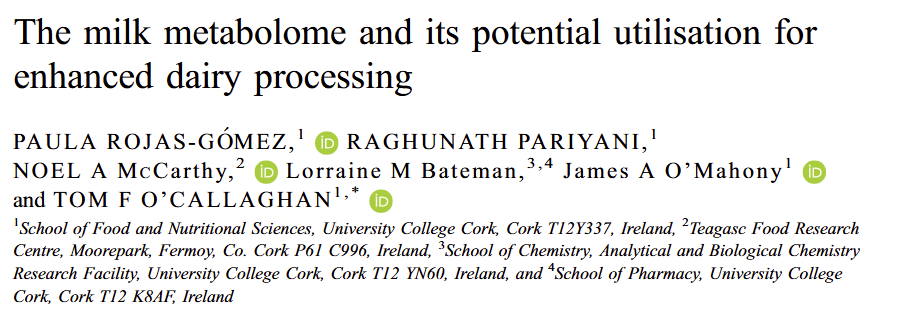 https://doi.org/10.3168/jds.2024-26168
https://doi.org/10.3168/jds.2024-26168
1. Abstract This study investigates the impact of varying proportions of pasture (high, medium, no-pasture) in the diet of cows and seasonality on the milk metabolome throughout lactation using proton nuclear magnetic resonance (1H-NMR) spectroscopy. This study explored the potential to differentiate milks from varying levels of pasture in the cows diet and highlight potential biomarkers for authentication A total of 54 spring calving cows were assigned to the 3 diet treatments for the duration of lactation. Weekly bulk milk samples were collected from each herd. Over 37 weeks (March–November), 43 metabolites representing diverse chemical classes, including amino acids and nitrogenous compounds, carbohydrates, volatile fatty acids, organic acids, and alcohols were quantified. Significant dietary and seasonal influences on the milk metabolome were characterized, with signature differences attributed to the proportion of pasture in the cow's diet and the season of milk production. Receiver operating characteristic (ROC) analysis of the milks from different feeding systems across lactation highlighted the potential of the milk metabolome to distinguish pasture from non-pasture derived milks, with a series of metabolites demonstrated as excellent biomarkers, including hippurate. Multivariate analysis also highlighted dimethyl sulfone as key metabolite for the distinction between different diet regimens. These findings highlight the diversity and complexity of the composition of milk as affected by seasonality, and signature characteristics that are associated with pasture-based feedings systems. As “Grass-Fed” dairy products become more prominent on the market, the analysis of the milk metabolome using 1H-NMR shows significant promise for utilization as a tool for authentication purposes.
 https://doi.org/10.1016/j.foodchem.2025.145900
https://doi.org/10.1016/j.foodchem.2025.145900
2. Abstract Bovine colostrum-based functional foods are gaining recognition for their potential beneficial roles in human health. However, while macronutrient variability has been extensively studied, the impact of seasonality and diet on bioactive metabolome profile of colostrum remains poorly understood. This study employs UHPLC-HRMS to characterize the metabolic profile of day 0 colostrum from dairy cows calving in autumn and spring under distinct environmental and dietary conditions. An untargeted metabolomic analysis demonstrated distinct seasonal variations, with autumn-derived colostrum exhibiting a two-fold increase in 22 metabolites, including phospholipids, bioactive peptides, organic acids, and nucleotides. Glycyl aspartate and D-erythro-imidazole-glycerol-phosphate emerged as key biomarkers distinguishing seasonal colostrum. Pre-partum diet and environmental temperature were the significant determinants of metabolic differences, whereas parity and genetic merit, represented by the economic breeding index, had minimal influence. These findings highlight the impact of seasonality on the colostrum metabolome, providing novel insights for the development of colostrum-based functional foods.
 https://doi.org/10.1111/1471-0307.70058
https://doi.org/10.1111/1471-0307.70058
3. Abstract Background: Milk metabolomics has emerged as a valuable tool in dairy science, offering detailed insight into the molecular composition of milk. Understanding the milk metabolome is increasingly relevant to optimise milk quality, processability and traceability. As the dairy sector intensifies efforts to enhance product functionality and sustainability, metabolic profiling represents a promising approach to link animal physiology, farming practices and changes occuring during processing. Aims: This review aimed to collate current knowledge regarding the intrinsic and extrinsic factors influencing the milk metabolome and, as a result, how the milk metabolome impacts milk techno-functionality. This review explores primary production variables, such as diet, breed, environment and management practices, and their effects on milk composition and processability. Methods: A comprehensive literature review of the subject matter was conducted across relevant studies, selected based on their focus on milk metabolomics in the context of dairy production and processing. Emphasis was placed on publications from 2010 to 2025 to capture recent advances and emerging trends. Major findings: The milk metabolome is affected by multiple intrinsic and extrinsic factors, including species, breed, diet, stage of lactation and health status, each of which influences nutritional value and processability of milk. As such, several milk metabolites, including choline, acetate and myo-inositol, have been correlated with gelation, a key techno-functional indicator. Furthermore, some metabolites have been highlighted as biomarkers of cow feeding systems such as hippurate, a biomarker of pasture-based feeding. Scientific and Industrial Implications Understanding the determinants and consequences of milk metabolome variations offers new opportunities to improve dairy product quality, tailor processing conditions and support the development of farming and traceability strategies.